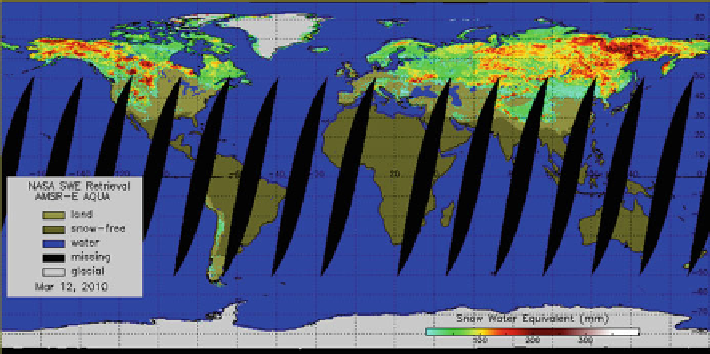Environmental Engineering Reference
In-Depth Information
Fig. 14.3
Example of a global map of snow water equivalent (SWE) derived from observations of
AMSR-E onboard Aqua satellite. SWE retrievals are not reliable and therefore are not performed
over Antarctica and most of Greenland. AMSR-E SWE retrievals are available from National
Snow and Ice Data Center (NSIDC) at
http://nsidc.org/
snow depth (SD) or snow water equivalent (SWE) from observations in the micro-
wave usually assume a linear relationship between SD or SWE and the difference of
microwave brightness temperatures at 19 and 37 GHz. Figure
14.3
presents an
example of a global SWE map derived from observations of AMSR-E instrument
onboard Aqua. These maps have been generated at NASA daily since 2002 at the
spatial resolution of 25 km.
The most notable limitations of microwave observations consist in their rela-
tively coarse spatial resolution (currently 10-50 km) and in poor sensitivity to
shallow and melting snow (Walker and Goodison
1993
). Cold rocks exhibit a
spectral response in the microwave similar to the one of snow (Grody and Basist
1996
). As a result microwave algorithms tend to confuse cold rocks with snow
cover and thus overestimate snow in the mountains. Because of a tendency to miss
shallow and melting snow, microwave products typically underestimate the snow
extent in the beginning and in the end of the snow season. Armstrong and Brodzik
(
2001
) have found that the SSM/I and SMMR data-based algorithm maps consis-
tently have less snow over the Northern Hemisphere as compared to NOAA
interactive snow charts. The difference in the estimated snow-covered area ranges
from 2% in early spring to 25% in late fall. In the same time, anomalies in the yearly
average in the snow extent derived from SSM/I demonstrate a noticeable correla-
tion with NOAA interactive charts.
Snow depth and snow water equivalent estimates from observations in the
microwave are limited only to dry snow packs. The reported errors of the snow
water equivalent range within 5-45 mm over non-forested areas and increase by
5-10 mm over forests (e.g., Singh and Gan
2000
; Pulliainen et al.
1999
; Tait
1998
).
This corresponds to 40-100% if the error is expressed as a percentage error of the
total SWE. Kelly et al. (
2003
) put the estimate of the accuracy of microwave snow

Search WWH ::

Custom Search